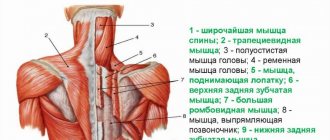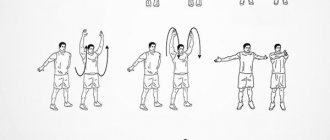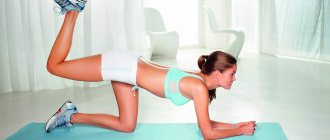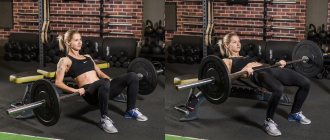Types of stretching exercises
Exercises for stretching the leg muscles can be divided into several types:
| Type of stretch | Description |
| Static | It is especially suitable for beginners, as it is gentle on the muscles. They stretch, but do not tense. Do these exercises for 15 seconds to a minute. You can train any muscle groups. |
| Dynamic | The essence is completely opposite to the static one. These movements are characterized by dynamics and active actions. Raising your arms, lunging your legs, twisting your body. |
| Passive | It differs from static in that it is performed in pairs. Here it is important to feel your body and react in time to your partner’s actions, to tell him how hard to push or pull. This stretching allows you to stretch your muscles even better and increase your range of motion. |
| Active | It is in many ways similar to dynamic, but its main difference is independent actions and working with your own weight. This stretching often acts as a complement to another type, but can also be independent. |
| Ballistic | This is a specific type and is not suitable for everyone. Unlike smooth movements, these exercises are performed rhythmically and intensely - jumping, pushing, sharply and with maximum amplitude. |
How to warm up your legs before stretching?
At the beginning of training, experts recommend short stretching of muscles and joints. This important stage cannot be ignored or skipped.
Due to it, a rush of blood begins to flow to the muscles, and joint fluid is released. The effectiveness of further training of the lower extremities depends on a good warm-up before stretching, because if the muscles are not warmed up, there is a risk of ligament rupture during sports.
Benefits of warming up:
- improved plasticity;
- development of stability and coordination of movements;
- acceleration of blood circulation;
- oxygen saturation of muscles;
- increasing the flexibility of joints and tendons;
- reducing the risk of damage;
- improved posture;
- feeling of lightness;
- increased muscle performance.
Main goals:
- muscle tone;
- increased muscle temperature;
- reduction of overvoltage;
- increasing training intensity;
- minimizing sprains;
- psychological preparation.
When to stretch your muscles: before, during exercise, after training?
Jacob Wilson, a sports physiologist at Florida State University, says stretching before exercise is important. However, this should not be a static form, you need to do a dynamic warm-up. And after classes, stretch to calm the body and bring the pulse back to normal (book “Cardio or Strength” by Alex Hutchinson).
Citing the same source, it can be noted that Jason Winchester, a scientist from Louisiana State University, is confident that you should not stretch before strength exercises . But stretching after training is a must. If such exercises are planned, it is good if enough time passes before the main strength exercises. You can also do them on non-training days, for example in the morning or before bed.
It is also a good idea to stretch the working muscles between sets of strength exercises. Not for long, literally 10-15 seconds.
Warm up before stretching
Experiments on rats at the University of Michigan showed that muscles must be warmed up before stretching, otherwise they will be severely injured. Experts advise warming up before stretching - jogging, cycling to warm up properly (book “Cardio or Strength” by Alex Hutchinson).
How and how long to stretch?
Ideally, stretching your legs should take 10-15 minutes. On average, stretching lasts about 10-20 minutes. Before it starts, you should restore your pulse.
Contraindications for leg stretching
Anyone can do stretching, regardless of age or athletic training.
But in some cases this process must be approached with caution:
- previous spinal injuries;
- damage to the hamstrings, inguinal ligaments;
- diseases of the hip joints;
- acute pain in the lower back;
- bruises of the limbs;
- cracks in the bones;
- high blood pressure;
- exercises during pregnancy in consultation with a doctor and trainer;
- dizziness;
- muscle spasms;
- uterine prolapse;
- elevated temperature.
Warnings:
- there is no need to try to swing your body to stretch stronger or deeper - this can cause injury;
- Proper breathing during training is the key to success; it should be rhythmic and even;
- At the end of the session, the muscles should be relaxed.
Stretching your leg muscles is not only necessary, but also beneficial. The main thing is to do this correctly and carefully, adhering to the trainer’s recommendations. Stretching your legs increases your range of motion, helps strengthen your joints, and prevents injuries and muscle pain when playing sports.
Exercises for the front of the thigh
In this section, we will look at the basic movements for stretching the front of the thigh (quadriceps).
Lying quadriceps stretch
- Lie face down on the mat.
- Raise your head, move your hand back and clasp your ankle with it.
- Pull your foot toward your buttock, while keeping your thigh pressed to the floor.
- Do the same with the other leg.
You can also use a rubber shock absorber or a jump rope here:
© Mihai Blanaru — stock.adobe.com
Single Knee Quadriceps Stretch
- Get down on one knee, as if in a lunge.
- Place your hand on your front leg. With your other hand, grab the toe of your other foot and pull it towards your buttock. Try to tighten your gluteal muscles.
- Do the same with the other leg.
© Kzenon — stock.adobe.com
Deep Lunge
- Take a deep lunge forward. The back leg should be straight.
- Lean your body forward and place your hands on the floor on either side of your front leg.
- The leg laid back is bent so as to reach the floor with the knee. Stretch forward, pushing your knee, you will feel the quadriceps of that leg stretch.
- Now repeat with the other leg.
© Syda Productions - stock.adobe.com
Muscle stretching for splits
To learn how to do longitudinal or transverse splits, you need to perform a set of the following exercises daily:
- A standard exercise for any type of stretching is bending forward from a standing position. Feet should be placed together, back straight. Bend forward with your arms extended. When bending, you need to bring your chest as close to your knees as possible. Stretch your face towards your feet as far as possible. Remain in this position for 15-20 seconds, repeat the exercise 3 times.
- Stand up straight with your legs together, arms extended at your sides. Place the right leg forward 100-110 cm from the left. Bend your torso forward, sliding your hands evenly along your extended leg, pulling your chest toward the thigh of your right leg. Fingers reach forward or touch the floor. You need to stay in this position for 25-30 seconds, then change legs.
- Sit on the floor, spreading your legs as wide as possible. Bend the torso forward, trying to touch the chest and head to the floor, arms extended forward. Stay in the pose for 20-30 seconds. Perform 3-4 repetitions.
This exercise is the most effective for stretching at home. In just six months you will be doing the splits - Remaining in a sitting position with legs wide apart, bend to the sides, trying to reach your toes with your fingers. Fix the pose for 30-40 seconds for each leg.
- You need to lie on the floor with your knees bent. The right leg is raised up, while exhaling, they grab the foot and pull it towards themselves as far as possible. The left leg remains in its original position. To make the exercise easier, use a strap or strong tape to wrap your foot around your foot. It is necessary to remain in this position for 15-20 seconds, then perform it for the left leg.
To do the splits for a beginner, you need to practice for a long time. Stretching should be done for 4-6 months to prepare the muscles and joints. Gradually you need to increase the duration of each exercise by an average of 5 seconds.
Don't miss the most popular article in the section: Laser hair removal on the face and body - how it is done, effectiveness, before and after photos, contraindications.
Exercises for the outer thigh
Even untrained people can perform the exercise near the wall. And what is done while standing requires some preparation. But at the same time the abs are stretched.
Hip abduction against the wall
- Stand against the wall with your right side. Place your right palm on it.
- Place your right leg behind your left and squat down. The leg brought back should slide along the floor to the left without bending at the knee. Keep your body straight.
- Turn your other side to the wall and repeat.
Stretching while standing
- Place your left leg behind your right in front. The right hand is on the belt, the left is freely lowered down.
- Lean towards your lowered arm. You can also bend over with your arms raised above your head.
- Repeat for the other leg.
The importance of stretching in bodybuilding
A large number of sports and health fitness techniques are based on stretching exercises. But today we will talk about the positive effects of stretching specifically for those who practice strength training in the gym.
When performing strength exercises, muscles constantly contract, that is, they compress and then stretch. The same thing happens with ligaments and tendons.
With regular training, they gradually shorten a little , as if remembering the shortened (compressed) position and remaining in it even during the rest period.
This can lead to the shape of the muscle becoming less than aesthetically pleasing. In addition to deterioration in appearance, functionality also suffers - muscle flexibility and ligament elasticity decrease.
This has a negative impact on performance:
- The range of motion in exercises decreases
- Increased risk of injury
- The rate of recovery of muscles and ligaments deteriorates both during training and at the end of it
Strength sports specialists have known about all this for a long time. Therefore, professional athletes necessarily stretch before, during, and after strength training.
In this regard, the gluteal muscles are no exception. Stretching the buttocks in combination with strength training improves their shape. This technique is actively used in women’s training aimed at increasing muscle volume in this part of the body.
Exercises for shins
These are simple exercises that can be performed without sufficiently developed stretching.
Stretch against the wall
- Stand facing the wall at a distance of a small step, rest the toe of your right foot and palms against it, take the other leg one step back. The feet are pressed to the floor and do not come off throughout the entire exercise.
- Lean forward so that the knee of your right leg rests against the wall. The left one remains straight, and it is her lower leg that stretches.
- Repeat the movement for the other leg.
Heel Wall Stretch
- Stand in a position similar to the previous exercise, only now place the toe of your right foot on the wall and rest on your heel. Both legs are straight.
- Move your body forward, bending your right leg.
- Switch legs and repeat the exercise.
Anterior calf stretch
- Sit on your buttocks, legs straight.
- Bend one leg at the knee, place the foot on the thigh of the other leg and pull it towards the pelvis, helping with your hand. Pull the sock towards you.
- Do the same with the other leg.
Warm-up before leg training: 20 exercises
Preparation for the planned lesson is gradual - you cannot work at once at a wide amplitude. Warming up before leg training contains a whole arsenal of exercises. They activate the buttocks, quadriceps and hamstrings, adductors, and calves.
This set of exercises is also suitable for warming up before the splits. The only recommendation: repeat the cardio exercises in three sets to better warm up the muscles and ligaments before stretching into the splits. A well-warmed body will make it easier for you to stretch. To do this, look at: warm-up option FOR THE WHOLE BODY for 5 minutes.
Walking in place with knees raised
Start warming up your legs with regular walking in place. Take a classic sports stance - stand straight, hands at your sides, and feet slightly narrower than shoulder width. Alternately raise and lower your legs, move your bent arms along your body. Hips reach parallel to the floor. Maintain an average pace, don't rush anywhere.
How much to do: 10-15 lifts on each leg.
U-turns with arm extension
The movement is included in the pre-workout warm-up to prepare the core muscles, which are always involved during leg workouts. Take a position - spread your feet two shoulder widths apart, place your arms on your sides. Make a turn to the left, extend your straight right arm in that direction, and stand back up. Mirror, perform alternately, without pauses.
How much to do: 5-10 abductions for each arm.
Mill
Place your feet two shoulder widths apart, keep your body straight, straighten your elbows, and stretch your arms to the sides. Start bending over, twisting your body. With your right hand, reach for your left toe, stand up straight, do the same tilt in the other direction, and take the starting position. Don't bend your knees, don't crook your arms.
How much to do: 5-10 bends on each side.
Rotational movements in the hip joint
Place your feet at a distance of one and a half shoulder widths from each other, place your palms on your waist, on your sides. Start a rotational movement of your pelvis in the right direction (forward, right, back, left). Keep your head in place, do not bend your knees, do not lift your toes or heels. Repeat the rotation to the left.
How much to perform: 5-10 clockwise rotations and 5-10 counterclockwise rotations.
Standing Cat Pose
A variation of the classic cat pose. The modification is as follows: stand on your feet and place your palms on your thighs just above your knees. Bend your lower back, then round your back. The neck is straight and follows the trajectory. Spring your knees and firmly press your feet to the floor so as not to lose your balance.
How much to do: 10-15 arches.
Leg spins
Take a classic stance with your feet shoulder-width apart. Raise one leg until your thigh is parallel to the floor and your shin is at a right angle to it. Exactly, without changing the plane, turn your leg clearly to the side, make a rotation. Perform the warm-up exercise first on the right leg, then on the left leg.
How much to perform: 5-10 rotations on each leg clockwise and 5-10 rotations on each leg counterclockwise.
Circular rotations in the knee joints
This is a must-have movement for warming up before any workout that involves squats, lunges, or deadlifts. Stand up, place your palms on your thighs above your knees, and keep your feet together. Incline your body a little, squat slightly, rotate your knees in one direction or the other.
How much to perform: 5-10 clockwise rotations and 5-10 counterclockwise rotations.
Squat with arms thrown from bottom to top
Place your feet at a distance convenient for squats, raise your straightened arms up above your head. Begin to lower your pelvis until it is parallel to the floor, without bringing your knees behind your toes. At this time, move your hands between your legs to the middle of your shins. Rise to starting position, repeat.
How much to do: 10-15 squats.
In the leg warm-up, you can perform a simplified version of squats:
Lateral lunges with weight transfer
Effective for warming up the legs, as every muscle is captured. Stand with your feet far apart. Shift your center of gravity to the left side, bend your knee and lower your pelvis until it is parallel to the floor. Return to the original stand. Mirror without lifting your feet. Clasp your hands in front of you. Side lunges are great for warming up before doing the splits.
How much to do: 5-10 lunges on each side.
Rotations to warm up the ankles
The ankles are extremely vulnerable, so you should not forget about this place when warming up your legs. Place your feet slightly wider than shoulder-width apart and place your palms on your sides. Raise your left leg and perform a series of ankle rotations to the right and left. Do the same steps with the second leg.
How much to perform: 5-10 rotations on each leg clockwise and 5-10 rotations on each leg counterclockwise.
Cross swings at the support
Stand to the side of any support (such as a chair or wall). Place one hand on the support and the other on the belt. Move the leg farthest from the support to the side. Make a swing, bring it back and, bypassing the starting position, swing in front of the second leg. Keep your body level and position your pelvis clearly, do not wiggle. Switch sides and repeat the cross swing.
How much to do: 5-10 swing lunges on each leg.
Swing back and forth at the support
Stand to the side of a support (such as a chair or wall). Place one hand on the support, the other on the belt. At a moderate pace, begin to swing the leg farthest from the support forward and backward to the level of the pelvis. Pull the toe slightly towards you, bend your knee slightly. Perform for the second leg. These swings are great for warming up before the splits.
How much to do: 5-10 swing lunges on each leg.
Back lunges with arms raised
Take a normal stance with your arms along your body. Place one leg on your toes straight back, at an angle of 90 degrees between the shin and thigh, and place the other perpendicular to the floor at the knee joint. Raise your arms above your head as you step back. Push off, come back. Do this alternating legs.
How much to do: 5-10 lunges on each side.
In the leg warm-up, you can perform a simplified version of lunges:
Squat lean towards straight leg
Place one leg straight forward on your heel, bend the other slightly at the knee. Raise your opposite hand up above your head and place the other on your waist. Perform a cross tilt, reaching your toes with your fingers. Mirror it. This leg warm-up exercise is simple and very useful, as it warms up the hamstrings well.
How much to do: 5-10 bends on each side.
Pulling the thigh to the chest
Place your feet shoulder-width apart and keep your torso straight. Begin to slowly raise your leg, bent at the knee joint, towards your chest. Grab her at the level of the pelvis with your hands and pull her harder. Feel the stretch in your hamstrings. Repeat this with the other leg.
How much to do: 5-10 pull-ups on each side.
Pulling the lower leg towards the buttocks
Take a classic stance. Bend one leg at the knee and gently pull your heel toward your buttock, wrapping your arms around it to complete the movement. To better stretch the quadriceps femoris, make an effort and increase the amplitude. Do not overdo it so as not to injure muscle fibers.
How much to do: 5-10 pull-ups on each side.
Pulsating Tilts
Stand straight, move your feet to the distance for squats, stretch your arms up. Bend in the following sequence: to the right toe, in the center between the feet, to the left toe. Go back. Feel the tension in the back of your thigh. Don't bend your knees.
How much to do: 5-10 bends.
Imitation of jumping rope
Take a stance as for jumping rope - feet slightly apart, arms bent at the elbows, hands out to the sides. Jump in place, pushing off with both feet. Imagine doing this with a jump rope and start rotating your arms a little. Spring your knees, do not keep them straight.
How many to perform: 25-30 jumps.
Jumping Jack
Starting position – feet together, hands at your sides. Make a simultaneous jump with your legs spread to a greater distance and bring your palms together above your head. With one more jump, return to your original position. This dynamic exercise is great for an intense pre-workout warm-up.
Repeat the jump rope and jumping jack for 3 sets if you are warming up for the splits to better warm up your body.
How many to perform: 25-30 jumps.
Bends to calm your heart rate
Stand up straight, spread your feet slightly wider than your shoulders. Relax and lean towards your toes, shake yourself up, straighten up and raise your arms above your head. Do the exercise slowly, without sudden movements. Performed to restore breathing and smooth transition from warming up the legs to the main part of the lesson.
How much to do: 7-10 bends.









